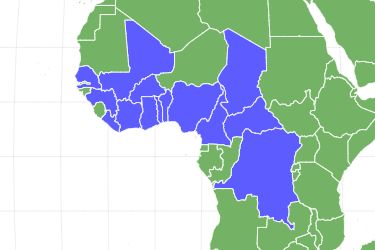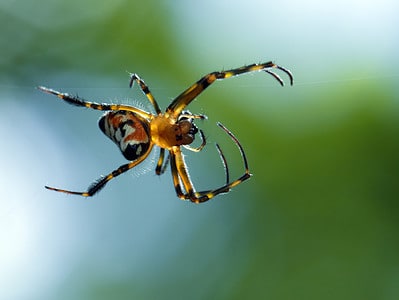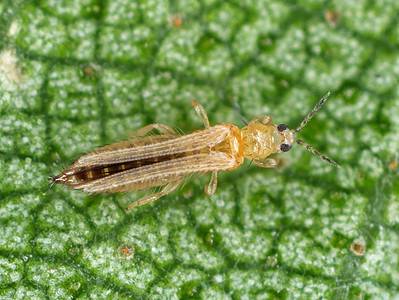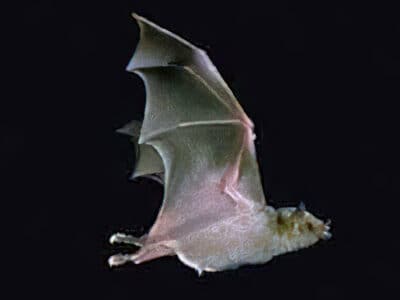Black Pastel Ball Python
Python regius
Advertisement
Black Pastel Ball Python Scientific Classification
- Kingdom
- Animalia
- Phylum
- Chordata
- Class
- Reptilia
- Order
- Squamata
- Family
- Pythonidae
- Genus
- Python
- Scientific Name
- Python regius
Read our Complete Guide to Classification of Animals.
Black Pastel Ball Python Conservation Status
Black Pastel Ball Python Facts
- Prey
- Small rodents and birds
- Main Prey
- Rats and mice
- Group Behavior
- Solitary
- Most Distinctive Feature
- High contrast coloration
- Other Name(s)
- Royal python
- Temperament
- Docile, curious, hardy
- Habitat
- Savanna, grassland, forests
- Diet
- Carnivore
- Lifestyle
- Nocturnal
- Common Name
- Ball python, royal python
View all of the Black Pastel Ball Python images!
“The black pastel ball python morph is characterized by its warm, earthy toned coloration and high contrast markings.”
Black Pastel Ball Python Summary
First bred in 2002 by Gulf Coast Exotics, the black pastel ball python is a unique color morph known primarily for its dark brown coloration and warm rust or golden-yellow patterning. While the majority of the snake’s patterning is more or less typical of that of a standard wild-type ball python, the exact tones of its browns and yellows are much more high-contrast and have a richer, warmer, more golden sheen.
The black pastel trait is a co-dominant trait, meaning only one black pastel parent is needed to produce offspring. To create the super or homozygous version of this morph, two black pastel snakes must be bred together.
While this morph has existed for decades and is quite popular in the exotic pet trade, it is important to note it has a few common genetic defects, primarily slight tail kinking and occasionally a mildly deformed “duckbill” face. Fortunately, these defects are fairly rare and not particularly damaging to the snake’s overall health or lifespan.
3 Amazing Black Pastel Ball Python Facts
- The black pastel morph is very similar to the cinnamon morph in appearance and coloration. The morphs were even developed around the same time in the early 2000s. Although the two lines are technically genetically distinct from one another, many breeders still debate how closely related the two morphs are.
- Super black pastel ball pythons are created by breeding two black pastel snakes together. The super black pastel morph is characterized by its solid chocolaty brown to black coloration with little to no patterning.
- Black pastel ball pythons commonly have reduced or broken-up patterning on their bellies, though the exact appearance of this patterning can vary.
Black Pastel Ball Python Evolution and History
Although it can technically occur naturally in the wild, the black pastel morph was first developed and documented in captivity by the breeders at Gulf Coast Exotics in 2002. Gulf Coast Exotics is based in Sarasota, Florida, and has been operating for more than 20 years.
Breeders developed the black pastel morph with the intention of creating a more vibrant, high-contrast snake with rich, golden, and rust-toned patterning. As a base morph, only one black pastel parent is needed to produce black pastel offspring. Experts have used this snake to create many newer, designer morphs, most notably the panda pied and the stunning silver surfer variety, both developed in 2008. Additionally, the super pastel morph is the homozygous form of the trait, which is created by breeding two black pastel snakes together.
Today, the black pastel morph is inexpensive, well-understood by many reptile breeders, and easily accessible within the exotic pet trade. It remains a popular choice for beginner reptile keepers who are interested in unique color morphs yet aren’t ready to commit to a more costly designer morph.
Where to Find Black Pastel Ball Pythons
The wild ball python lives in western and central Africa. It is quite hardy despite its small size. It tends to prefer grasslands, savannas, and forests.
The black pastel morph belongs to Python regius. The black pastel is a fairly uncomplicated base morph. This means it occurs naturally in the wild. Unfortunately, instances of this happening are rare.
Thankfully, the black pastel morph is now very common, accessible, and inexpensive within the exotic pet trade. Since 2002, many reputable reptile breeders have produced their own lines of black pastels, such as VPI and Tom Barnhart.
Because they are simple to breed in captivity and are typically in quite high demand, black pastel ball pythons are among the more affordable morphs on the market today. Snakes cost around $100 to $300, depending on the breeder you’re purchasing the snake from, the snake’s exact patterning and coloration, and the morph’s current supply and demand.
Today, most reptile breeders have their own websites and online shops where customers can easily purchase animals and have them shipped directly to their homes. Keep in mind that more complicated morphs that involve the black pastel morph can be significantly more costly, such as the panda pied, which can cost more than $1,500 per snake!
Black Pastel Ball Python Scientific Name
The ball python’s scientific name is Python regius, which translates to “royal python.”
Black Pastel Ball Python Population and Conservation Status
The ball python has been classified as near threatened since 2012. Unfortunately, it could become endangered in the future.
The ball python’s populations have been decreasing slightly in recent years. This is mainly due to habitat loss and hunting. Currently, experts do not know how many ball pythons exist.
How to Identify Black Pastel Ball Python: Appearance and Description
The black pastel morph features high-contrast coloration and rich, warm, chocolaty, golden, and sometimes reddish tones in its patterning. Aside from its slightly bolder colors, its overall appearance is quite similar to that of a standard, wild-type ball python. This makes it one of the subtler color morphs on the market today.
Ideally, a black pastel ball python will have a dark brown to black base color accented by golden yellow patterning. Its blacks and browns are usually darker and richer than that of a wild-type ball python. The exact color of the patterning can vary from a creamy off-white to sunny yellow to even a more auburn, rust tone. The morph’s dorsal patterning is also significantly reduced or not present at all.
Three traits you can use to identify a black pastel ball python:
- High contrast between base color and patterning
- Bolder patterning often with golden or reddish tones
- Little to no markings/patterning on the belly
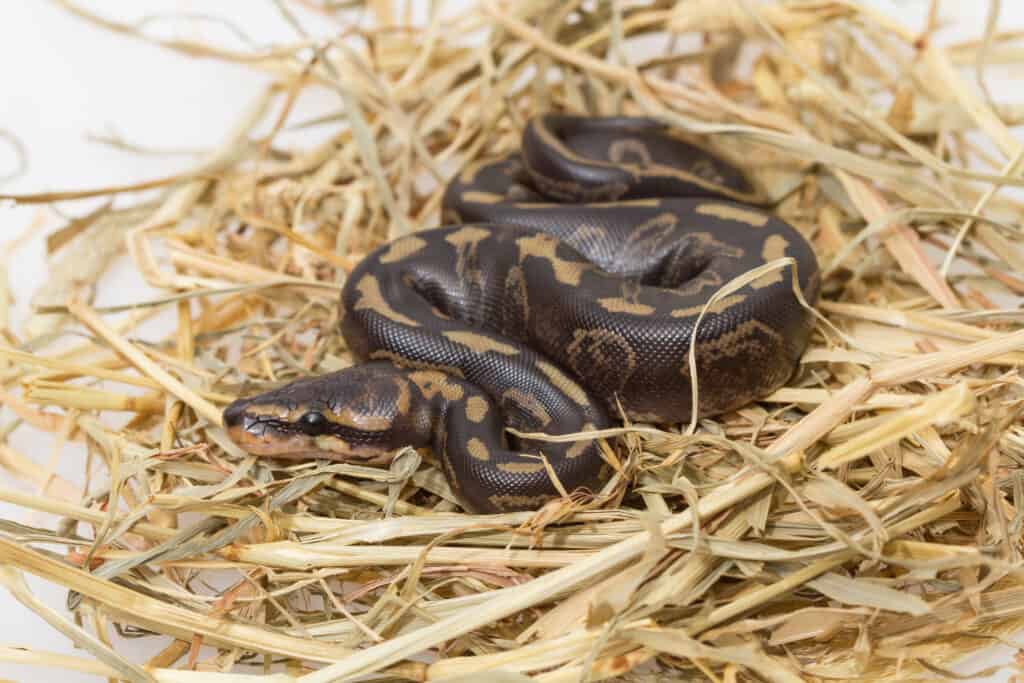
A black pastel ball python is black with cream or yellow spots.
©Bluedog Studio/Shutterstock.com
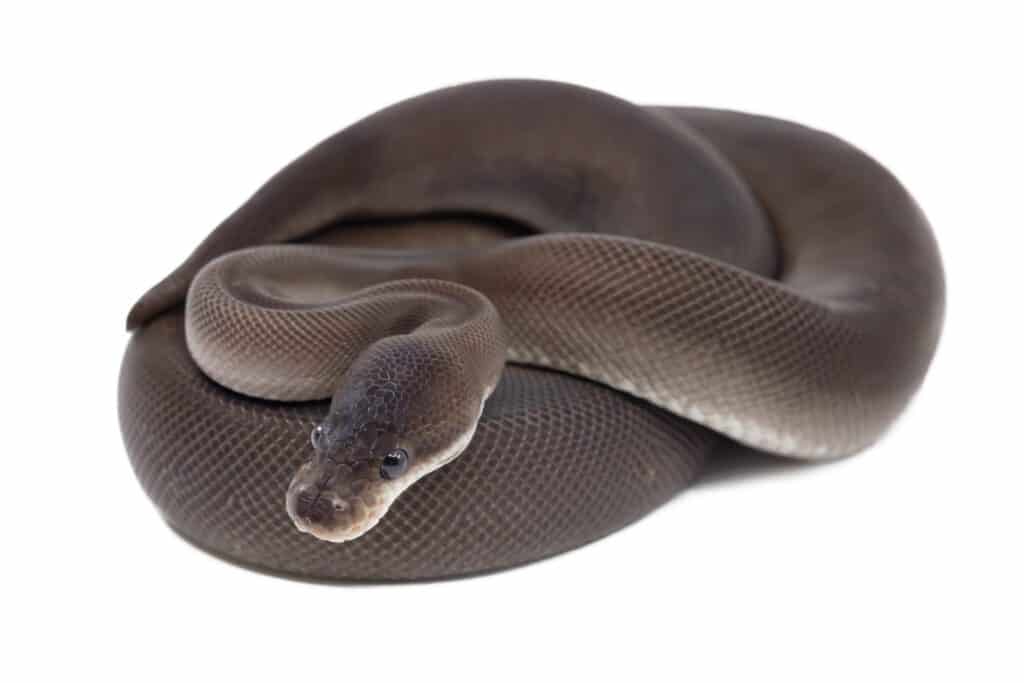
This black pastel ball python is light a dark grey color and does not have any yellow, gold, or brown patterns.
©Charnsitr/Shutterstock.com
Black Pastel Ball Python: How Dangerous Are They?
The ball python is a non-venomous constrictor snake. It is only 3 to 5 feet long, does not have fangs, and has a weak jaw. Its preferred prey are small birds or rodents. It is an ambush hunter that coils its body around its prey to suffocate them and then swallow them whole. Fortunately, it is far too small to consider a human as a meal.
The ball python gets its common name from its habit of curling up in a ball when feeling defensive. Rather than attacking, it will typically flee or curl up into this defensive position when approached by humans. Thanks to its small size and docile, hardy nature, the ball python has become one of the most popular and well-loved pet reptiles in the world.
Black Pastel Ball Python Behavior and Humans
The ball python first became popular in the exotic pet trade in the mid-1990s. Its small size, simple care requirements, and curious, gentle temperament have made it a favorite amongst reptile hobbyists worldwide. It can do well in small enclosures and fares quite well in captivity. It’s also very easy to breed in captivity, often producing five to 10 eggs in a single clutch.
More than 4,000 unique ball python morphs exist today. A wide range of breeders developed these morphs over the years. The black pastel morph was first developed and documented in 2002 by Gulf Coast Exotics.
The black pastel morph has certainly stood the test of time, remaining an incredibly popular, affordable option for reptile owners of all experience levels and backgrounds.
Related Animals
View all 285 animals that start with BBlack Pastel Ball Python FAQs (Frequently Asked Questions)
Are black pastel ball pythons venomous?
Ball pythons of all morphs are non-venomous constrictor snakes. They lack fangs and have small, weak teeth.
How do black pastel ball pythons hunt
Ball pythons are ambush hunters. They wait for a prey animal (usually a small rodent or bird) to cross their path before striking and latching onto the animal with their jaws. They will then quickly coil their body around the prey animal to suffocate it before swallowing it whole.
Are black pastel ball pythons aggressive?
Ball pythons are generally not aggressive towards humans. Most morphs, including the black pastel variety, share the same docile, slightly timid temperament.
Where do black pastel ball pythons live?
Ball pythons are native to Sub-Saharan Africa. In the wild, they prefer living in savannas, grasslands, and forested habitats. Black pastel ball pythons can technically occur naturally in the wild, though this is very rare. Most are born in captivity.
What do black pastel ball pythons eat?
The ball python’s preferred diet consists mainly of small rodents and birds. Occasionally, they will also feed on fish and amphibians. In captivity, most reptile owners feed their ball pythons captive-raised mice and rats.
How much do black pastel ball pythons cost?
The black pastel morph is a base morph that isn’t particularly rare. You can expect to pay around $100 to $300 or so for a black pastel ball python with no other traits. However, more complicated designer morphs that involve the black pastel morph, like the panda pied and silver surfer varieties, can cost well into the thousands of dollars for a single snake!
Are black pastel ball pythons rare?
Black pastel ball pythons are very common, affordable, and easily accessible within the exotic pet trade today. The black pastel morph has existed for more than 20 years and is fairly easy to reproduce in captivity. However, it is extremely rare in the wild.
Thank you for reading! Have some feedback for us? Contact the AZ Animals editorial team.
Sources
- IUCN Redlist (1970) iucnredlist.org/species/177562/15340592
- Oakland Zoo (1970) oaklandzoo.org/animals/ball-royal-python
- Morphpedia (1970) morphmarket.com/morphpedia/ball-pythons/black-pastel/
- World of Ball Pythons (1970) worldofballpythons.com/morphs/black-pastel/

